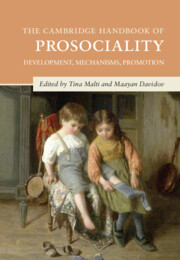Book contents
- The Cambridge Handbook of Prosociality
- Cambridge Handbooks in Psychology
- The Cambridge Handbook of Prosociality
- Copyright page
- Dedication
- Contents
- Figures
- Contributors
- Part I Development of Prosociality
- 1 Introduction: What Is Prosocial Development?
- 2 Developmental Theories of Prosociality
- 3 The Role of Genetics in the Development of Prosocial Behavior
- 4 Neurobiology of Prosociality
- 5 The Developmental Psychophysiology of Prosociality
- 6 The Origins of Prosociality from a Developmental and Comparative Perspective
- 7 Prosocial Behavior in Infancy and Early Childhood
- 8 Prosociality in Middle Childhood
- 9 Prosocial Behaviors in Adolescence
- 10 Prosocial Development across the Lifespan
- Part II Antecedents and Mechanisms of Prosociality
- Part III Development of Prosociality in Context
- Part IV Applications
- Index
- References
5 - The Developmental Psychophysiology of Prosociality
from Part I - Development of Prosociality
Published online by Cambridge University Press: 25 May 2023
- The Cambridge Handbook of Prosociality
- Cambridge Handbooks in Psychology
- The Cambridge Handbook of Prosociality
- Copyright page
- Dedication
- Contents
- Figures
- Contributors
- Part I Development of Prosociality
- 1 Introduction: What Is Prosocial Development?
- 2 Developmental Theories of Prosociality
- 3 The Role of Genetics in the Development of Prosocial Behavior
- 4 Neurobiology of Prosociality
- 5 The Developmental Psychophysiology of Prosociality
- 6 The Origins of Prosociality from a Developmental and Comparative Perspective
- 7 Prosocial Behavior in Infancy and Early Childhood
- 8 Prosociality in Middle Childhood
- 9 Prosocial Behaviors in Adolescence
- 10 Prosocial Development across the Lifespan
- Part II Antecedents and Mechanisms of Prosociality
- Part III Development of Prosociality in Context
- Part IV Applications
- Index
- References
Summary
For four decades, developmental scientists have been examining the links between children’s and adolescents’ prosociality and the activity of their peripheral physiological systems. In this chapter, we review the theories and studies that evaluate these links. In particular, we emphasize that the developmental psychophysiology of prosociality needs to be understood as involving dynamic and nonlinear processes occurring within the immediate contexts of evocative situations and shaped by the enduring contexts of close relationships.
Keywords
- Type
- Chapter
- Information
- The Cambridge Handbook of ProsocialityDevelopment, Mechanisms, Promotion, pp. 85 - 107Publisher: Cambridge University PressPrint publication year: 2023



